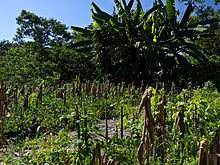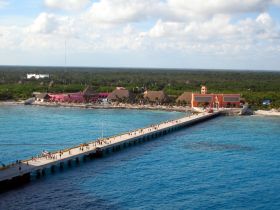How's the economy in Yucatan: Riviera Maya, Playa del Carmen, Cancun, Merida, etc?
Denis Larsen - Casa Hamaca Guesthouse
 I can’t speak for the economy for the whole Yucatan, Mexico but I can speak for where I live, in Valladolid, which is mid way between Cancun and Merida. There are probably three tiers of the economy – agriculture, education, and tourism. The town I live in has roughly 70,000 people. It acts as the county seat, so there are a number of small towns that are satellites.
I can’t speak for the economy for the whole Yucatan, Mexico but I can speak for where I live, in Valladolid, which is mid way between Cancun and Merida. There are probably three tiers of the economy – agriculture, education, and tourism. The town I live in has roughly 70,000 people. It acts as the county seat, so there are a number of small towns that are satellites. The town has over nine institutes of higher education, so there are a lot of students here at...
 I can’t speak for the economy for the whole Yucatan, Mexico but I can speak for where I live, in Valladolid, which is mid way between Cancun and Merida. There are probably three tiers of the economy – agriculture, education, and tourism. The town I live in has roughly 70,000 people. It acts as the county seat, so there are a number of small towns that are satellites.
I can’t speak for the economy for the whole Yucatan, Mexico but I can speak for where I live, in Valladolid, which is mid way between Cancun and Merida. There are probably three tiers of the economy – agriculture, education, and tourism. The town I live in has roughly 70,000 people. It acts as the county seat, so there are a number of small towns that are satellites. The town has over nine institutes of higher education, so there are a lot of students here at any time, plus a lot of teachers, and because of that, there are a lot of cultural activities that show up in various schools. The only things that aren’t here are hard sciences and medicine. Almost anything else you can get as an undergraduate degree here. And a lot of the kids who go to school here live in small villages, so on Friday afternoon the bus station is packed and Sunday evening it is packed again when they’re returning from home.
Before I ended up coming here, I had planned to retire in the US somewhere in New England in a college town because I like the idea of being around the culture that a college town brings that you can be exposed to.
We also have agriculture here. People drive in from Cancun and all they see are trees; the road is absolutely boring. Behind those trees are fields and farms, but you can’t see them. Many people still grow crops the way their ancestors did. The northern part of the Yucatan Peninsula is limestone with a very, very thin coating of soil, so far mechanization does not exist here. People plant like they did a thousand years ago. They use a 4-foot stick with an iron point on it; they poke a hole in the ground, put the seeds in, cover it over, and look for the next spot deep enough to get the iron point in.
Once you leave the town, people live here literally like they did a thousand years ago. They might have a bicycle now, a machete, something like that, but they don’t necessarily have water in their house, they don’t necessarily have electricity and they cook on the floor with fire. it is a juxtaposition of – and it is one of the reasons I’m here, very specifically – indigenous Mayan culture and the colonial culture that the Spanish brought some 470 years ago.
From Cancun, Valladolid is the first colonial city that you hit going west. It is named after Valladolid in Spain, which is not unusual, as are many places in Mexico and Latin America that are named after places in Spain. In the town itself, there are probably 50,000 to 55,000; in the county roughly 70,000.
(Traditional Mayan farming technique, milpas, where various crops are grown on one field, pictured.)
Posted September 24, 2015
Jason Waller - Playa del Carmen Real Estate
 Residential, commercial and retail in the Riviera Maya is booming. They’re bringing in malls like crazy. All top name brands. There is a group here that’s based in Mexico City and New York City that has a US $1 billion fund for commercial real estate here. They’re buying up hotels. They’re building a mall right now where they bought a whole block of 5th avenue and a whole of block back of it on both sides—it’s a huge section where...
Residential, commercial and retail in the Riviera Maya is booming. They’re bringing in malls like crazy. All top name brands. There is a group here that’s based in Mexico City and New York City that has a US $1 billion fund for commercial real estate here. They’re buying up hotels. They’re building a mall right now where they bought a whole block of 5th avenue and a whole of block back of it on both sides—it’s a huge section where... Residential, commercial and retail in the Riviera Maya is booming. They’re bringing in malls like crazy. All top name brands. There is a group here that’s based in Mexico City and New York City that has a US $1 billion fund for commercial real estate here. They’re buying up hotels. They’re building a mall right now where they bought a whole block of 5th avenue and a whole of block back of it on both sides—it’s a huge section where they’re building the mall and a boutique hotel. Hyatt just built huge hotel on the beach in Playa Del Carmen. All the big names are all coming out here. So the commercial real estate is just booming.
Residential, commercial and retail in the Riviera Maya is booming. They’re bringing in malls like crazy. All top name brands. There is a group here that’s based in Mexico City and New York City that has a US $1 billion fund for commercial real estate here. They’re buying up hotels. They’re building a mall right now where they bought a whole block of 5th avenue and a whole of block back of it on both sides—it’s a huge section where they’re building the mall and a boutique hotel. Hyatt just built huge hotel on the beach in Playa Del Carmen. All the big names are all coming out here. So the commercial real estate is just booming. They’re building resorts all down the coastline constantly. We’ve got another really cool thing, They were just approved to build a Dreamworks theme park out here and they’ve started clearing the land for it. They’ve got a Cirque du Soleil back here now that will be here on a permanent basis. Next to that, they’re building a Dreamworks theme park. It’s going to tie in with Cirque du Soleil. There’s a lot of money coming in.
The industry out here is tourism, which is dominant in the economy here. There is no other industry really here. It’s not a farming area. There’s no mining here. It’s tourism, and it’s booming.
There are a lot of people who are opening businesses. Nowadays, everything is online. So there’s many businesses being run from here that you don’t even know are being run here because it’s all done online. We have people who go back once every couple of months for whatever they need to do and then make their living from the beach.
I’ve got a friend that has a physiotherapy business back in Chicago and his partner stayed there. He hired somebody to do his stuff and then he works from here in Playa del Carmen. Now his plan is to move the office to Playa Del Carmen. When he does, the office work will be done here and he’ll hire people here and everything will be done from here. They’ll have a therapist on site in Chicago but all the behind the scenes stuff will all be run from here.
(Gingerbread house and Santa Claus at the Hyatt Regency, Merida, Yucatan, Mexico, pictured.)
Posted November 25, 2015
Gustavo Cisneros - Petén
 The economy in Yucatan varies depending per area.
The economy in Yucatan varies depending per area. Cancun (in the state of Quintana Roo) is doing very good because tourism in Mexico is going up. We got back into the Top 10 in the world when it comes to tourism and the number of visitors that come. Cancun is the most visited place in Mexico, especially by foreigners. Cancun has a US dollar based economy and it is very good. You will see a lot of growth in Cancun. There are new investments and new hotels,...
 The economy in Yucatan varies depending per area.
The economy in Yucatan varies depending per area. Cancun (in the state of Quintana Roo) is doing very good because tourism in Mexico is going up. We got back into the Top 10 in the world when it comes to tourism and the number of visitors that come. Cancun is the most visited place in Mexico, especially by foreigners. Cancun has a US dollar based economy and it is very good. You will see a lot of growth in Cancun. There are new investments and new hotels, all over the Riviera Maya (which includes Cancun, Playa del Carmen, Tulum, and other areas). That area is booming.
The state of Campeche, on the other hand, is an oil-based economy. That area is depressed as the areas in the US that are based on oil prices. They are low at this moment.
The state of Yucatan is somewhere in the middle. It is growing. We are attracting investments, tourism, and we have a more diversified economic structure than the other two states of the Yucatan Peninsula. We have some production of basic grains. The service industry has become the strongest part of the economy in Yucatan. We have had a lot of investment in the tourist areas, in the hospitals, in the universities, etc. This area is becoming very attractive.
The oil industry in Mexico was controlled by the government and now it has been opened for private investors. This is attracting a lot of people. People are not basing their operations in Campeche because the quality of the infrastructure in those areas is not up to the standards of the people that are coming to invest. So I believe and most of the people think that a lot of people will come to Merida just to live there because Merida has the standards that people want. Usually, the husband or the person who is the breadwinner would work in Campeche or but their families would live in Merida since Merida has all the services. The universities in Merida are also preparing to receive people who want to work in the technical areas or the oil industry.
Other than that, the country of Mexico has spent a lot of time, money, and effort on attracting engineers and technical mathematicians. They are trying to make something similar to Silicon Valley in some areas of Mexico. The quality of life in the Yucatan is so nice that people get attracted to it. Bright, intelligent people who want to live in a city with all the services of a big city come to live here and they can work anywhere else in the world. If you compare Merida to the rest of the country of Mexico, we are not in the fastest growing categories. The states that are closer to the US and the states that are in the center of Mexico are booming because the American economy is growing and they depend a lot on that. There are other states that have a big lack so the state of Yucatan is somewhere in the middle. Mexico has 32 states and the Yucatan is usually on the 15th or the 16th when it comes to economic growth. It is a state that has a lot of prospects. It is diversified and it is betting on the right things.
(View from a cruise ship of Costa Maya, Yucatan, Mexico, pictured.)
Posted March 8, 2016
Thomas Lloyd - Top Mexico Real Estate
 The main economic driver in the state of Quintana Roo (in the Yucatan) is tourism, and tourism is very strong, having been growing in the last several years. The occupancy rate in Quintana Roo has increased at a constant level.
The main economic driver in the state of Quintana Roo (in the Yucatan) is tourism, and tourism is very strong, having been growing in the last several years. The occupancy rate in Quintana Roo has increased at a constant level. New tourism continues to show favorable numbers; so much so that Hyatt is investing, not just in one hotel, but in two. Cirque du Soleil come down as well and occupies a permanent structure right here in the Riviera Maya (in the...
 The main economic driver in the state of Quintana Roo (in the Yucatan) is tourism, and tourism is very strong, having been growing in the last several years. The occupancy rate in Quintana Roo has increased at a constant level.
The main economic driver in the state of Quintana Roo (in the Yucatan) is tourism, and tourism is very strong, having been growing in the last several years. The occupancy rate in Quintana Roo has increased at a constant level. New tourism continues to show favorable numbers; so much so that Hyatt is investing, not just in one hotel, but in two. Cirque du Soleil come down as well and occupies a permanent structure right here in the Riviera Maya (in the state of Quintana Roo, including Cancun, and Playa del Carmen). These facts provide evidence that large companies are choosing to invest for the long term here.
With regard to population growth, Cancun is a very new city, and today it has a population of around 1.5 million. Playa del Carmen has been cited as the community with the fastest growing population growth, not just in Mexico, but in all of Latin America. Jobs have been created, tourism is going well, and the population booming in the state of Quintana Roo, so it has a very strong economy.
As we go over to the state of Yucatan to the Merida zone, the population has also been growing, more from sources within Mexico. There are a lot of people over the last several years who have moved from Monterey, Mexico City, and from other cities of Mexico into Merida.
(Cirque du Soliel, Quintana Roo, Mexico, pictured.)
Posted April 21, 2016


